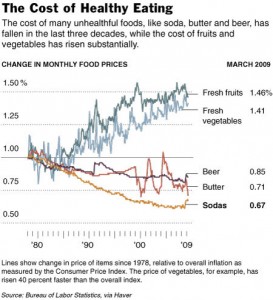Bad news on food prices: up, up, and away
The FAO (Food and Agriculture Organization of the U.N. has just released its 2010 food price index. Compared to 2002-2004, commodity food prices sharply increased, especially those of sugars and fats.
The new index is higher than in 2008 when people throughout the world rioted in protest. It is also at the highest level recorded since the index began in 1990.
What’s going on? In 2008, FAO explained the crisis as the result of the combined effects of:
- Competition for cropland from the growth in biofuels
- Low cereal stocks
- High oil prices
- Speculation in food markets
- Extreme weather events
I’ve discussed other possible explanations I’ve collected in previous posts.
This time, supply problems in grains, sugars, and meat are making the problemworse. FAO experts are predicting that prices will go even higher this year.
High food prices are a disaster for the poor and are also a ticket to social disorder. World leaders: get to work!
Added clarifications: It turns out that the FAO food price index is not inflation-adjusted. Oops. This means that the prices are not necessarily higher than they were in 2008. Nevertheless, food riots are already happening. Ben Grossman-Cohen of Oxfam sends this report of such disturbances in Algeria, for example.


